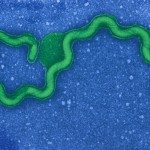Link to Pubmed [PMID] – 25063661
Appl. Environ. Microbiol. 2014 Oct;80(19):6091-103
Leptospira spp. are spirochete bacteria comprising both pathogenic and free-living species. The saprophyte L. biflexa is a model bacterium for studying leptospiral biology due to relative ease of culturing and genetic manipulation. In this study, we constructed a library of 4,996 random transposon mutants in L. biflexa. We screened the library for increased susceptibility to the DNA intercalating agent, ethidium bromide (EtBr), in order to identify genetic determinants that reduce L. biflexa susceptibility to antimicrobial agents. By phenotypic screening, using subinhibitory EtBr concentrations, we identified 29 genes that, when disrupted via transposon insertion, led to increased sensitivity of the bacteria to EtBr. At the functional level, these genes could be categorized by function as follows: regulation and signaling (n=11), transport (n=6), membrane structure (n=5), stress response (n=2), DNA damage repair (n=1), and other processes (n=3), while 1 gene had no predicted function. Genes involved in transport (including efflux pumps) and regulation (two-component systems, anti-sigma factor antagonists, etc.) were overrepresented, demonstrating that these genes are major contributors to EtBr tolerance. This finding suggests that transport genes which would prevent EtBr to enter the cell cytoplasm are critical for EtBr resistance. We identified genes required for the growth of L. biflexa in the presence of sublethal EtBr concentration and characterized their potential as antibiotic resistance determinants. This study will help to delineate mechanisms of adaptation to toxic compounds, as well as potential mechanisms of antibiotic resistance development in pathogenic L. interrogans.

